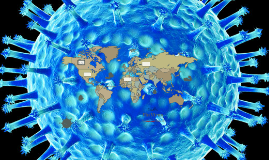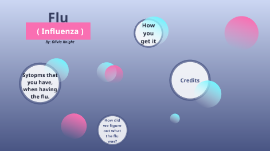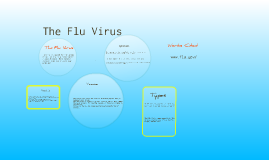FLU VIRUS
Transcript: Influenza viruses continually change over time, usually by mutation (change in the viral RNA). This constant changing often enables the virus to evade the immune system of the host (humans, birds, and other animals) so that the host is susceptible to changing influenza virus infections throughout life. This process works as follows: A host infected with influenza virus develops antibodies against that virus; as the virus changes, the "first" antibody no longer recognizes the "newer" virus and infection can occur because the host does not recognize the new flu virus as a problem until the infection is well under way. The first antibody developed may, in some instances, provide partial protection against infection with a new influenza virus. Flu vaccine reduces the average person chance of catching it by up to 80% during the flu season. However, people who get vaccined one year aren’t protected from getting the flu the following year because the protection wears off and flu viruses change constantly. EPIDEMIOLOGY MICROBIAL AGENT FLU VIRUS FLU INTRO The flu can be determined by symptoms to the point where further testing is not needed. These symptoms are fever, headache, tiredness, dry cough, sore throat, congested nose, and muscle aches and stiffness. Other symptoms may be nasal discharge, shortness of breathe, wheezing, croupy cough, chills, fatigue, malaise, sweating, loss of apetite, vomiting, dizziness, and worsening of other illnesses such as asthma and/or heart failure. The flu usually begins abruptly, with a fever of 102- 106F. Adults usually have a lower temperature than a child. Other common symptoms include a flushed face, body aches, headache, nausea, and lack of energy. The fever typically last for a day or two but can last five days. Somewhere between the second and fourth day of the illness, the whole body symptoms should begin to subside, and the respiratory symptoms should begin to increase. The flu virus can settle anywhere in the respiratory system, producing symptoms of a cold, croup, sore throat, bronchiolitis, ear infections, or pneumonia. Symptoms should start to disappear around four to seven days. But the tiredness and coughs usually lasts for weeks after the illness is over CONTROL MEASURES SYMPTOMS PREVENTION A LOOK INSIDE In 1918 infectious diseases were beginning to be unraveled. Influenza is a highly infectious viral illness. The name “influenza” originated in 15th century Italy, from an epidemic attributed to “influence of the stars.” The first pandemic, or worldwide epidemic, that clearly fits the description of influenza was in 1580. At least four pandemics of influenza occurred in the 19th century, and three occurred in the 20th century. The pandemic of “Spanish” influenza in 1918–1919 caused an estimated 21 million deaths worldwide. The first pandemic of the 21st century occurred in 2009–2010.Smith, Andrews, and Laidlaw isolated influenza A virus in ferrets in 1933, and Francis isolated influenza B virus in 1936. In 1936, Burnet discovered that influenza virus could be grown in embryonated hens’ eggs. This led to the study of the characteristics of the virus and the development of inactivated vaccines. The protective efficacy of these inactivated vaccines was determined in the 1950s. The first live attenuated influenza vaccine was licensed in 2003 The Flu is the common named influenza which is a virus that attacks the respiratory system. The flu virus releases its genetic information into the cells nucleus to replicate itself. When the cell dies, those copies are released and they affect other cells throughout the rest of the body. With that happening the virus weakens the immune system. When your sick with the flu, your body builds up a defense by making antibodies against it. The flu virus spreads through air when a person coughs, sneezes, or speaks. Its important to treat the flu seriously because it can lead to other viruses such as pneumonia and other life-threatening complications. For the most part it appears in infants, senior citizens, and people with long term health problems. People with the flu may not know but they are actually contagious from a day before they feel sick. It would usually be one week for adults and two weeks for young kids. Anyone at any age can have serious complications with the flu but those at high risk are people over 50 years old, children between 6 months and 2 years, women more than 3 months pregnant the flu season, anyone living in a long-term care facility, and anyone with chronic heart, lung or kidney conditions, diabetes, or weakened immune system.

















